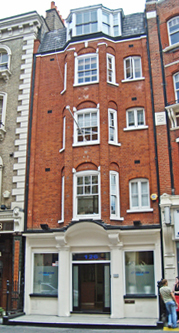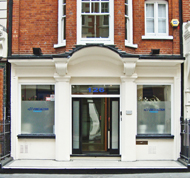Physical Treatment of
Disabled Officers
Physiotherapy
Dr Robert Fortescue Fox (1858-1940), the leading balneologist in the country, advocated physical treatment (physiotherapy) as aftercare for various types of war disablement. He formed a committee and collected sufficient funds to enable provision of free treatment to officers at the Alexandra Therapeutic Institute on certain days of the week.
The Institute had been established at 126 Great Portland Street some years before the war as a private enterprise. It was fully equipped with electrical apparatus and various forms of baths, and had its own trained staff. One of the owners, Mr King, was also the manager.
The Physical Clinic for Wounded and Disabled Soldiers opened early in July 1916. However, within three months, the arrangement was found to be insufficient to meet the demands for treatment and the British Red Cross Society was asked to help.
The Society agreed to take over the Institute from Mr King and his partner, but to retain Mr King's services and to pay for all the outgoings - rent, rates, taxes, etc - in respect of the building.
The Institute closed for a week in September for more apparatus to be installed. A number of baths and appliances were added to those already in situ, including a complete series of adapted and improved Zander instruments which helped to restore the use of stiffened and deformed limbs and joints. Also installed was a whirlpool bath, designed to prepare the injured limb for manipulation (either while it was still in the bath, or for dry manipulation later) and to help mitigate the pain.
The Institute reopened on 2nd October 1916 under the control of the British Red Cross Society, who renamed it the Red Cross Clinic for the Physical Treatment of Disabled Officers. A medical superintendent was appointed to take responsibility for the work, while an Honorary Consulting Medical Committee, with Dr Fortescue Fox as Chairman, visited the Clinic regularly to examine and prescribe treatments for the patients. Various disabilities which had arisen from serious wounds were treated - inflammatory swellings, rheumatic and neurotic pains, adhesions, and loss of muscular power. Officers of all the Allied nations were treated at the Clinic, and hospitals for officers in various parts of London used it as a special Out-Patients' Department. Patients attended regularly - some for two years - and no distinction was made between those still in service and those discharged.
In 1918 an arthrometer, an appliance enabling accurate measurement of the movement of joints, was developed by Wilbraham Falconer, the medical superintendent of the Clinic. It was manufactured commercially as Falconer's arthrometer.
The Clinic closed in 1919.
Present status (July 2010)
The building now contains the offices of First Action Finance.


126 Great Portland Street.
(Author unstated) 1916 Physical clinic for wounded and disabled soldiers. British Medical Journal 1 (2895), 897.
(Author unstated) 1916 Physical clinic for wounded and disabled soldiers. British Medical Journal 2 (2897), 58.
(Author unstated) 1916 Physical clinic for wounded and disabled soldiers. British Medical Journal 2 (2909), 472.
(Author unstated) 1917 Physical treatment of disabled soldiers. British Medical Journal 1 (2945), 767.
(Author unstated) 1917 Red Cross Clinic for the Physical Treatment of Disabled Officers. The Red Cross 4, 24-25.
(Author unstated) 1921 Reports by the Joint War Committee and the Joint War Finance Committee of the British Red Cross Society and the Order of St John of Jerusalem in England on Voluntary Aid Rendered to the Sick and Wounded at Home and Abroad and to British Prisoners of War, 1914-1919. London, HMSO (reprinted in facsimile, 2009. The Naval and Military Press Ltd in association with the Imperial War Museum), p. 256.
War Disablement Committee of the Section of Balneology and Climatology of the Royal Society of Medicine 1917 Statement and recommendations on physical treatment for disabled soldiers. Proceedings of the Royal Society of Medicine 10, 75-77.
Return to home page